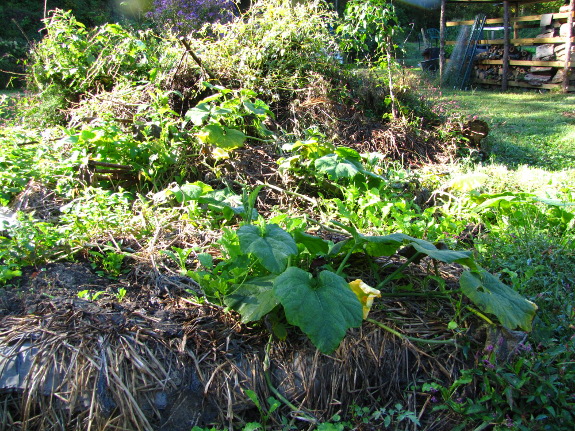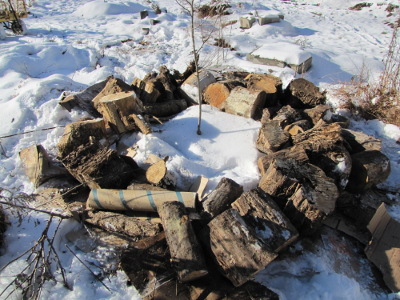
Do wood and straw raise soil potassium levels?
 Week before last was the uncritical
summary of Steve Solomon's The
Intelligent Gardener,
but this week I want to look at his claims in more depth. For
example, Solomon wrote that potassium is
found in large amounts in woody stems of trees and in lignified stalks
of grasses, so if you practice hugelkultur or mulch with straw, your
potassium levels are going to be too high. Sure enough, my
potassium levels are higher than recommended, but is it due to the wood
and straw?
Week before last was the uncritical
summary of Steve Solomon's The
Intelligent Gardener,
but this week I want to look at his claims in more depth. For
example, Solomon wrote that potassium is
found in large amounts in woody stems of trees and in lignified stalks
of grasses, so if you practice hugelkultur or mulch with straw, your
potassium levels are going to be too high. Sure enough, my
potassium levels are higher than recommended, but is it due to the wood
and straw?
To test Solomon's
hypothesis, I compared the forest garden aisles with the forest garden  beds. The aisles
haven't been treated in any way except for constant mowing (plus chicken
tractoring from 2006
to 2010, which was also done in the areas that are now beds).
Since this spot is our most waterlogged part of the garden, the beds
were built up above the ground using horse manure, wood chips, rotting
wood, and other odds and ends of organic matter. If Solomon's
hypothesis is correct, the potassium levels in the beds should be off
the charts, with lower levels found in the aisles.
beds. The aisles
haven't been treated in any way except for constant mowing (plus chicken
tractoring from 2006
to 2010, which was also done in the areas that are now beds).
Since this spot is our most waterlogged part of the garden, the beds
were built up above the ground using horse manure, wood chips, rotting
wood, and other odds and ends of organic matter. If Solomon's
hypothesis is correct, the potassium levels in the beds should be off
the charts, with lower levels found in the aisles.
| Aisles | Beds | |
| CEC | 6.2 | 10.92 |
| pH | 6.3 | 7.2 |
| %OM | 5.43 | 9.95 |
| S | 40 | 36 |
| P | 118.36 | 499.84 |
| Ca |
1305 | 2596 |
| Mg |
261 | 654 |
| K |
592 | 918 |
| Na | 55 | 31 |
| Ca % sat | 52.66 | 59.45 |
| Mg % sat | 17.55 | 24.96 |
| K % sat | 12.25 | 10.78 |
| Na % sat | 1.94 | 0.63 |
| other % sat | 5.1 | 4.2 |
| H % sat | 10.5 | 0 |
| B | 0 | 0.98 |
| Fe | 354 | 430 |
| Mn | 48 | 62 |
| Cu | 4.16 | 5.08 |
| Zn | 8.2 | 16.84 |
| Al | 654 | 432 |
As you can see in the
table above, the absolute amount of potassium in the soil is higher in the beds, but
potassium's percent saturation is lower. If your head is
whirling, remember that the cation
exchange capacity
(CEC) determines how many positively charged ions can stay put in the
soil, and CEC is increased by adding organic matter. The higher
CEC in the forest garden beds gives room for many more cations, so even
though using lots of woody amendments increased the absolute amount of
potassium in the bed, the cations are actually more in balance in the
beds than they are in the untreated aisles.
In fact, my new
hypothesis is that organic matter acts as a buffer in the soil, evening
out all kinds of imbalances. I've read that adding lots of
organic matter to your soil acidifies it, but in my own garden, areas
with more organic matter are more alkaline and seem to have a better
ratio of the big three cations. Perhaps the Rodale-based
organic gardening method is right after all?
This
post is part of our The Intelligent
Gardener lunchtime series.
Read all of the entries:
|
Want more in-depth information? Browse through our books.
Or explore more posts by date or by subject.
About us: Anna Hess and Mark Hamilton spent over a decade living self-sufficiently in the mountains of Virginia before moving north to start over from scratch in the foothills of Ohio. They've experimented with permaculture, no-till gardening, trailersteading, home-based microbusinesses and much more, writing about their adventures in both blogs and books.
Want to be notified when new comments are posted on this page? Click on the RSS button after you add a comment to subscribe to the comment feed, or simply check the box beside "email replies to me" while writing your comment.

Hi Anna,
Good questions and analysis.
Another BIG variable is type of lab processing.
Strong acid, weak acid, water to name 3 that give different results.
While it is hard to do. I would start by looking at what the lab actually measured and how they turned it into the numbers you see. Also, measuring the plants can be quite informative to see what minerals actually wound up in the plants. Which plants did well which did more poorly?
Once consultant claims that much more gypsum (calcium sulphate) 2-3X what is 'needed' results in sweeter (higher Brix) plants. Along that line my understanding is that boron should be 1/1000 of calcium. So your boron levels are quite low ( if you believe your lab! ).
But I think your suspicion about more organic matter (humic stuff) is a good idea and is sound.
Int'l agrilabs just published the results of their high brix butternut squash contest. Most interesting. A 3 to 1 variation in Brix between growers!!!
Brix testing can be a good start and you can try various teas to see what effect they have on your plants as they grow! Real time feedback!
Also, compare the difference between two or more similar plots with different treatments.
John
Chemistry is a complex subject. Especially in a medium like soil, which has many organic and anorganic constituent substances along with bacteria, fungi and other organisms.
It would therefore not surprise me if different types of soil tested and reacted quite differently.
In science, hypotheses are tested in order to become theories. It is done that way becuase it works. This includes proper control tests to rule out unforeseen side effects. And the resulting theories are specific to the tested circumstances, e.g. "in a soil with average composition x adding y results in ...". So for a theory about soil condition to be valid in many soil compositions it either has to tested in all of them or it must be provable through other means that soil composition doesn't affect the results of the test.
I wonder how many of these "garden chemistry" writers tested their hypotheses on any more than the soil in their backyard?
Hi Roland and Anna,
Good point.
I look for experience in producing results that can be measured by real farmers.
There are several tapes on Int'l agri website. Mike Astra's comments and other publications are well informed and candid. Raju Titus has some really worthwhile comments.
Today, I have been reading Dr. Norman Deno's book "Seed Germination Theory and Practice" Now in the public domain and part of the USDA library. IMHO - Well worth your time.
Happy growing :).
John
The reason you don't need to figure the atomic weights in when computing soil nutrient levels is because is it listed on a IONIC CHARGE basis, rather than a weight. This is so it jives with the CEC that is given on an equivalent basis. That's why you need to multiply the atomic weight out when adding the amendments.
I have heavy clay where I garden that has excess Mg in it as well. Our root crops in particular benefit from the addition of Gypsum, but I haven't had the time to do anything scientific
I'm glad someone is taking the time to do some science behind the Albrect and Solomon theory though. Personally, I think it may got back to sodium availability rather than Ca/Mg ratio. Ion availability is complex but varies with atomic weight, pH, ionic charge, and concentration.
..I'm not sure about Solomon's claim about organic matter, per se, exagerating nutrient defiencies, because plants can concentrate nutrients against a gradient. That being said, wood is high in potassium compared to other micronutrients required by plants.